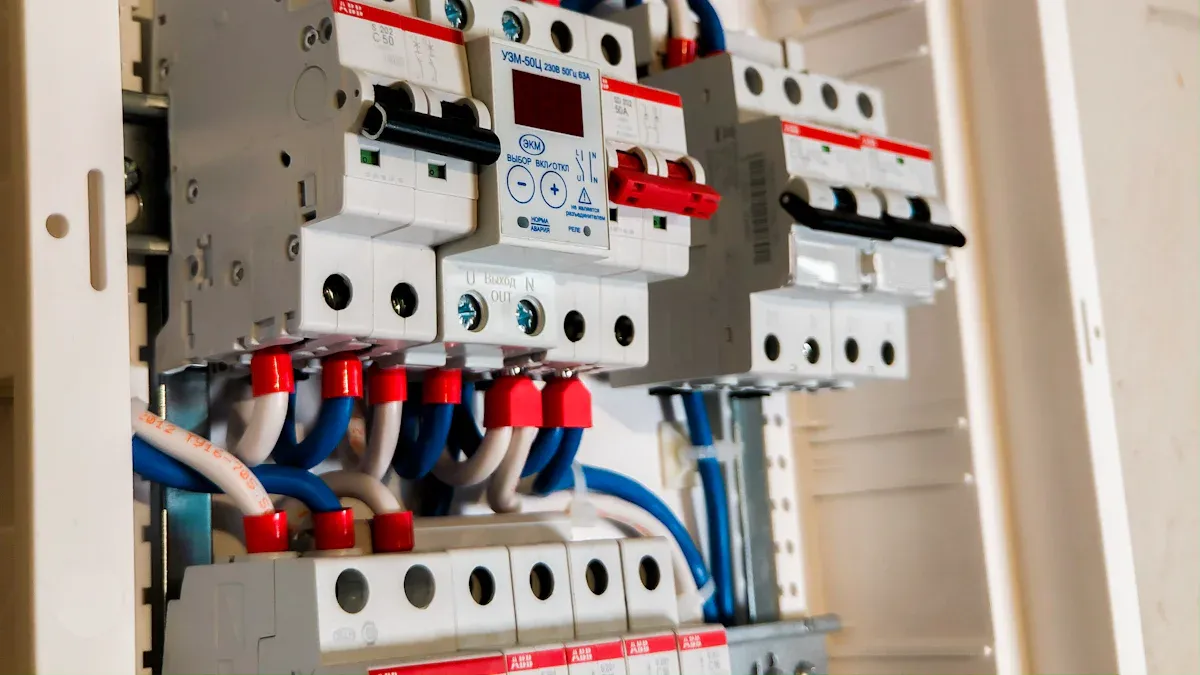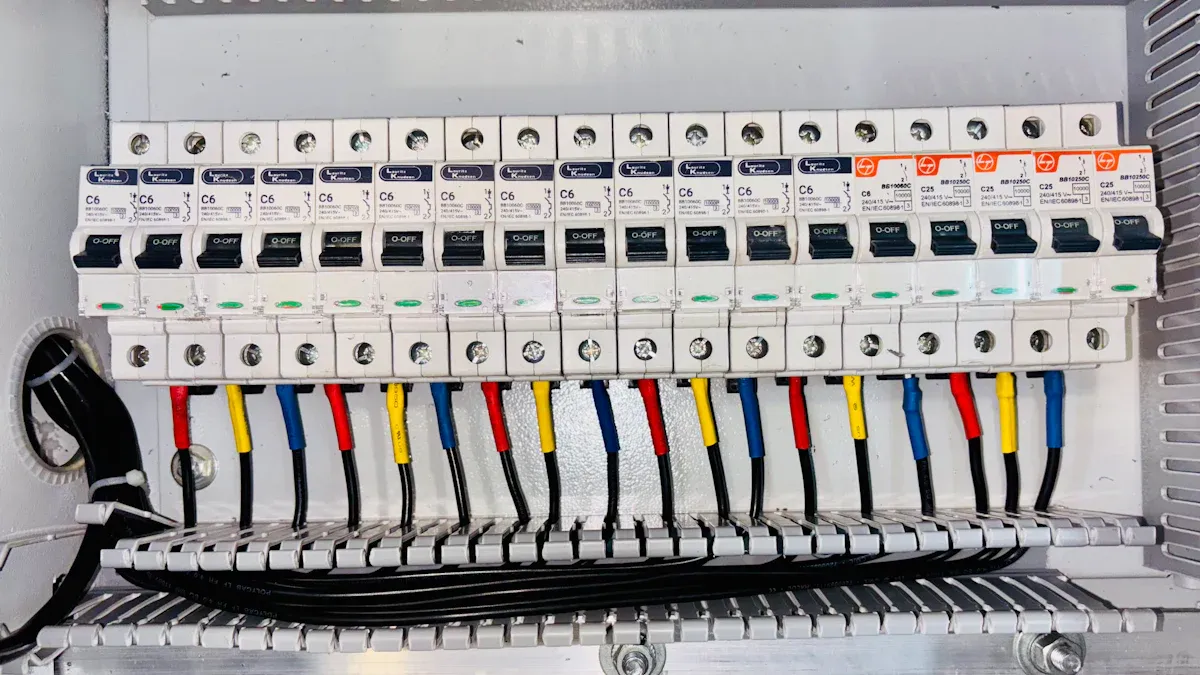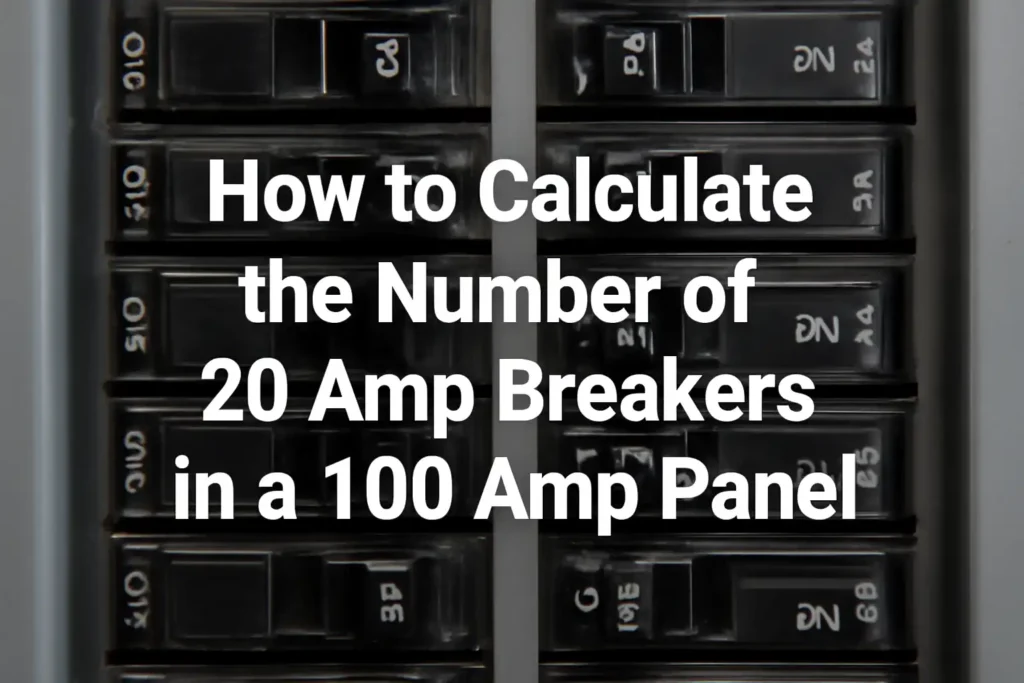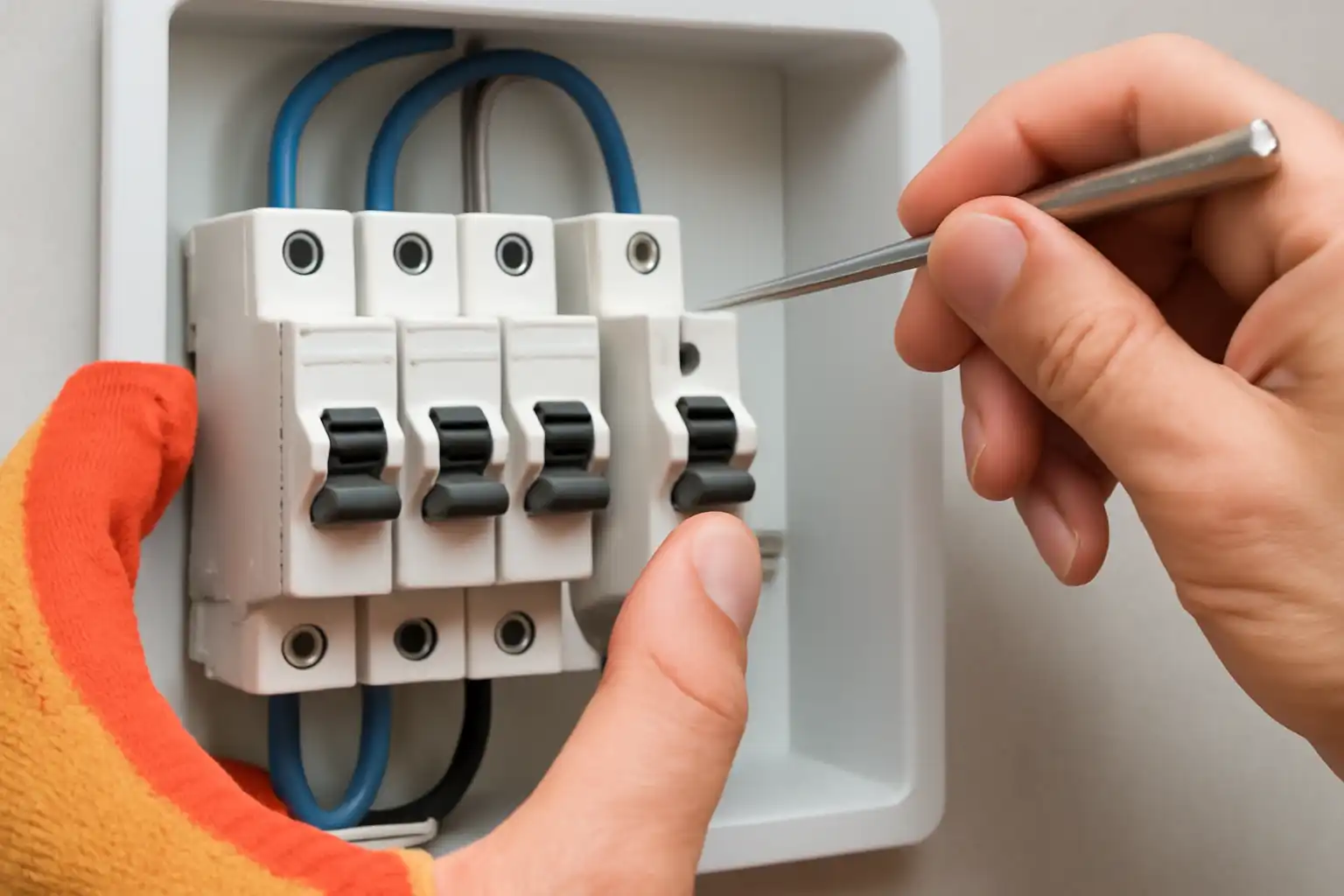A 100-amp panel can support 12 to 16 circuits with 20 ampere circuit breakers. You need to keep it safe and efficient. Continuous loads should not go over 80% of the panel’s capacity. This helps stop overheating and keeps it working well. For a 100-amp panel, the maximum continuous load is 80 amps. If you overload the panel, breakers might trip or equipment could get damaged. Calculating the load correctly avoids these problems. It also helps you follow local electrical rules. These steps keep your circuits safe and working properly.
Key Takeaways
- A 100 amp panel can handle 12 to 16 circuits safely. Use 20 amp breakers, but check the total load to prevent overheating.
- Follow the 80% rule: keep continuous loads under 80 amps. This helps avoid safety issues and breaker trips.
- To find how many 20 amp breakers you need, divide 80 amps by 20 amps. This means you can have up to 4 breakers for continuous loads.
- Think about future needs when adding breakers. Leave room for more circuits so your panel doesn’t get overloaded later.
- Always ask a licensed electrician for help. They can make sure your setup is safe and follows local rules.
Understanding Panel Capacity

What Is a 100 Amp Panel
A 100 amp panel is often found in older homes. It is the main box that spreads electricity around your house. Power comes from the utility company to this panel. Then, it sends electricity to circuits protected by breakers. These breakers stop overloads and keep things safe.
| Characteristic | Description |
|---|---|
| Type | A load center, also called a panelboard or breaker box, is a metal electrical box. |
| Function | It takes incoming power and sends it to circuits in the home. |
| Protection | Breakers protect each circuit from overloads. |
| Typical Usage | A 100 amp panel works well for older homes with basic needs. |
| Amperage Capacity | Handles 60 to 80 amps for lights and appliances. |
Homes built before 2000 often use 100 amp panels. These panels are fine for lights and regular appliances. But if you have big devices like EV chargers or modern HVAC systems, you might need a bigger panel.
How Panel Capacity Relates to Circuit Breakers
Your panel’s capacity decides how many breakers it can hold. A 100 amp panel can have many circuits, but the total load must stay within its limit. For example, adding several 20 amp breakers means their combined load must fit the panel’s capacity.
Experts say breaker terminals should be at least 75% of the panel’s poles. This ensures the panel can handle the circuits it’s designed for. Too many breakers or too much load can cause overheating and danger.
The Role of the 80% Rule in Electrical Safety
The 80% rule is key for keeping electrical systems safe. It says continuous loads shouldn’t go over 80% of the panel’s capacity. For a 100 amp panel, this means no more than 80 amps for long-running devices like air conditioners.
Following this rule stops overheating and keeps the panel working well. If you add 20 amp breakers, check the total load to stay under 80 amps for continuous use. This keeps your system safe and reliable.
Tip: Always ask a licensed electrician to check your math and follow local codes.
How to Calculate the Number of 20 Ampere Circuit Breakers

Step 1: Find Out Your Panel’s Total Capacity
First, learn how much power your 100 amp panel can safely handle. This is the maximum current it can manage without problems. Rules like the National Electrical Code (NEC) help guide this process.
Here’s how to figure out the total capacity:
- Use the formula I = P / V, where:
- I means current in amps.
- P is total power in watts.
- V is circuit voltage.
- Add extra circuits for future needs.
- Include a 20% safety margin for heat effects.
For example, if your home has lights, kitchen appliances, and laundry circuits, calculate the power each uses. Add 1,500 volt-amperes for each 120-volt 20-amp kitchen and laundry circuit. Also, include the wattage of fixed appliances like heaters or air conditioners to find the total load.
Tip: NEC lets you use demand factors in calculations. This helps ensure your panel fits your home’s needs.
Step 2: Use the 80% Rule for Long-Running Devices
After finding the total capacity, apply the 80% rule for devices that run for three hours or more. These are called continuous loads, like heaters or air conditioners. NEC says circuit breakers should only handle 80% of their rating for these loads.
Why is the 80% rule important?
- Wires must be sized at 125% of the continuous load.
- Breakers protect these wires for safe use.
- For example, a 200A continuous load needs wires sized for 250A (125% of 200A). The breaker protects the 250A wires.
For a 100 amp panel, the maximum continuous load is 80 amps (100 x 0.8). This keeps the panel cool and working well.
Note: Always separate continuous and noncontinuous loads. Add 125% of continuous loads to 100% of noncontinuous loads to find the total panel load.
Step 3: Figure Out the Number of Breakers
Now that you’ve used the 80% rule, calculate how many 20 amp breakers your panel can hold. Each breaker adds to the total load, so make sure the combined load stays within the panel’s limit.
Follow these steps:
- Divide the panel’s maximum continuous load (80 amps) by each breaker’s rating (20 amps).
- 80 ÷ 20 = 4. This means the panel can hold four 20 amp breakers for continuous loads.
- For noncontinuous loads, use the full panel capacity (100 amps). Divide this by the breaker rating:
- 100 ÷ 20 = 5. This allows five breakers for noncontinuous loads.
- Think about what devices each breaker powers. Big appliances may need their own circuits, lowering the number of breakers you can add.
Example Calculation:
If your panel supports 80 amps for continuous loads and you install three 20 amp breakers, the total load is 60 amps (20 x 3). This leaves space for one more breaker, keeping the panel safe.
Reminder: Always ask a licensed electrician to check your math and follow local rules.
Example Calculation for 20 Ampere Circuit Breakers
Let’s go through an example to figure out how many 20 amp circuit breakers can fit in a 100 amp panel. Follow these simple steps to understand the process.
Step 1: Find the Panel’s Maximum Continuous Load
Use the 80% rule to calculate the highest continuous load your panel can handle. Multiply the panel’s capacity by 0.8:
Maximum Continuous Load = Panel Capacity × 0.8
Maximum Continuous Load = 100 amps × 0.8 = 80 amps
This shows the panel can safely handle up to 80 amps for devices that run continuously.
Step 2: Check the Load of Each Breaker
Each 20 amp breaker adds 20 amps to the total load. Make sure all breakers together stay under the 80-amp limit for continuous loads.
Step 3: Divide the Maximum Load by Breaker Size
To find the number of breakers, divide the maximum continuous load by the breaker size:
Number of Breakers = Maximum Continuous Load ÷ Breaker Rating
Number of Breakers = 80 amps ÷ 20 amps = 4 breakers
This means you can safely install four 20 amp breakers for continuous loads.
Step 4: Consider Non-Continuous Loads
For non-continuous loads, use the full panel capacity (100 amps). Divide this by the breaker size:
Number of Breakers = Panel Capacity ÷ Breaker Rating
Number of Breakers = 100 amps ÷ 20 amps = 5 breakers
The panel can hold five breakers for non-continuous loads.
Example Scenario
Imagine you have these continuous loads:
- A heater using 20 amps
- An air conditioner using 20 amps
- A water heater using 20 amps
These three devices use 60 amps (20 × 3). Since the panel’s limit is 80 amps, you can add one more 20 amp breaker. For non-continuous loads, like a microwave, you can use the remaining 20 amps of the panel’s full capacity.
Tip: Leave extra space for future needs. Overloading the panel can cause overheating or tripped breakers.
Summary Table
Here’s a simple table to summarize:
| Load Type | Panel Capacity Used | Number of Breakers Allowed |
|---|---|---|
| Continuous Loads | 80 amps | 4 |
| Non-Continuous Loads | 100 amps | 5 |
By following these steps, you can safely figure out how many 20 amp breakers your panel can handle.
Factors That Affect Breaker Installation
Continuous vs. Non-Continuous Loads
Knowing the difference between continuous and non-continuous loads is important. Continuous loads run for long periods, usually three hours or more. Examples are air conditioners, heaters, and store lighting. Non-continuous loads run for shorter times, like microwaves or drills.
Here’s a simple comparison:
| Load Type | Description |
|---|---|
| Continuous Load | Devices that run for long periods under normal or tough conditions. |
| Non-Continuous Load | Devices that work for short times or on and off cycles. |
When figuring out breaker capacity, use the 80% rule for continuous loads. This helps the panel handle heat from devices running a long time. Non-continuous loads can use the full breaker capacity. Always separate these two load types to avoid overloading the panel.
Device Power Use and Load Type
Every device on your panel has specific power needs. You must check these needs to calculate the total load. Important things to consider include:
- Power efficiency
- Energy waste (THD)
- Real energy use
- Extra energy needed
- Total energy used
- Tools to measure power
For example, devices with low power efficiency use more energy and create more heat. This affects how many breakers your panel can safely hold. Use these details to calculate the load correctly and keep your panel working well.
Tip: Look at the manufacturer’s guide for each device to find its power needs.
Local Electrical Rules and Codes
Electrical rules differ by location, so follow your area’s guidelines. These rules keep systems safe and prevent problems. They may limit the number of breakers in a panel or require special wiring for some devices.
Breaking these rules can cause fines or unsafe setups. Check with your local building office or an electrician to ensure you follow the rules. This step keeps your installation legal and safe.
Reminder: Always focus on safety and follow local rules when setting up breakers.
Common Mistakes When Installing 20 Ampere Circuit Breakers
Overloading the Panel
Overloading the panel is a frequent mistake with 20 amp breakers. This happens when the total load is too high for the panel. It can cause overheating, tripped breakers, or even fires. To prevent this, calculate the load carefully and stay within limits.
Here are common mistakes that cause overloading:
- Forgetting to fully charge the logger before use.
- Placing the logger at the wrong panel or disconnect.
- Not checking if the power source is live, not switched.
- Skipping the step of labeling the power cord.
- Setting up the logger incorrectly.
- Failing to confirm that recording has started.
These errors can lead to wrong load calculations, increasing risks. Always check your setup and math to keep the panel safe.
Tip: Have a licensed electrician review your load calculations and setup.
Ignoring the 80% Rule
Ignoring the 80% rule can create serious safety problems. This rule ensures continuous loads don’t exceed 80% of the panel’s capacity. For a 100 amp panel, continuous loads must stay under 80 amps.
Here are real-world examples of ignoring this rule:
| Case Study Description | Outcome | Financial Impact |
|---|---|---|
| Ignored power disturbances for years | Equipment failures reduced after fixing the issue | Customers saved over $100K annually from lightning damage |
| Used a holistic design approach | Equipment failures dropped by 92% on average | No outages for over ten years in some cases |
| Skipped some recommendations | Minor equipment failures continued | Ongoing costs for replacing equipment |
These cases show why following the 80% rule is important. Proper load calculations prevent failures and save money over time.
Note: Separate continuous and non-continuous loads for accurate calculations.
Failing to Plan for Future Expansion
Not planning for future needs can limit your panel’s use and cost more later. When adding breakers, think about future appliances or circuits you might need.
Important points for future planning include:
| Key Considerations | Description |
|---|---|
| Extra Breaker Needs | Ensure proper connections with extra breakers and protection. |
| Safety and Liability | Engineers must address safety and compliance concerns. |
| Infrastructure Requirements | Additional infrastructure may be needed for future connections. |
Planning ahead avoids overloading and prepares your panel for future demands.
Tip: Leave room in your panel for future breakers and consult an electrician for a flexible design.
Knowing your panel’s capacity and using the 80% rule keeps your electrical system safe and working well. Correctly calculating the load stops overloads and protects your home from risks. Always check the type of load and follow local electrical rules to stay safe and meet requirements.
Reminder: If you’re unsure or have a tricky setup, ask a licensed electrician. They can help you avoid errors and make sure your system is safe.
By following these tips, you can handle your panel safely and keep your electrical system reliable.
FAQ
What happens if you go over the 80% rule?
Going over the 80% rule can cause overheating. Breakers may trip often, and fires could start. Your appliances might also get damaged. Always check your loads to stay safe.
Tip: Have a licensed electrician double-check your load calculations.
Can you use both 20 amp and 15 amp breakers together?
Yes, you can use 20 amp and 15 amp breakers in one panel. Just make sure the total load doesn’t exceed the panel’s limit. Each breaker must fit the wire size and device it powers.
How can you tell if your panel is too full?
If your panel is overloaded, breakers will trip a lot. Lights might flicker, or the panel could feel warm. Lower the load or call an electrician to check it.
Reminder: Check your panel often to avoid problems.
Is it okay to install breakers by yourself?
Installing breakers can be dangerous if you’re not trained. Mistakes might cause shocks, fires, or break the rules. Always follow safety steps and local codes.
Note: Call a licensed electrician for tricky jobs or if unsure.
Why do local codes matter for breaker installation?
Local codes set rules for breaker numbers and wiring. They keep your setup safe and legal. Ignoring them can lead to fines or unsafe systems.
Reminder: Ask your local building office before changing your panel.
The following information may be of interest to you
How many watts can a 20 ampere circuit breaker handle
How to Calculate the Load Capacity of a 32 Amp MCB
How to calculate the capacity of a circuit breaker
How to choose the appropriate size of circuit breaker




